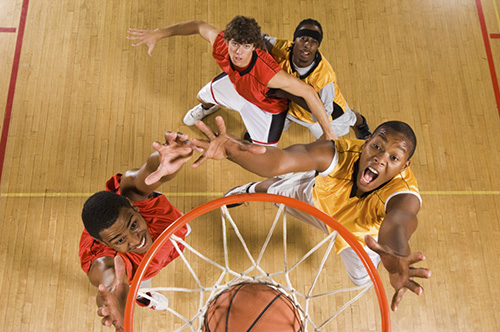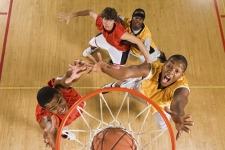Basketball originated in the United States in 1891 at a YMCA in Massachusetts. It started with the players trying to get the ball into a couple of hanging peach baskets. These days basketball is a popular sport in the United States, and the physical demands of the game mean there is an increase in common basketball injuries.

Sprains
Sprains are the most common of basketball injuries. This injury is to the lateral ligaments of the ankle that stabilize the ankle. There are three ligaments to the lateral ankle ligamentous complex, but the one that is most likely to be damaged is the anterior talofibular ligament (ATFL). This injury usually happens when a basketball player lands and the ankle rolls in.
This injury is prevented by taping the ankle or by using a brace. However, if a sprain occurs, the symptoms include pain in the area of the ankle that was overstretched. There is typically swelling of the ankle, and it will be warm to the touch and tender. Also, there may be bruising.
Treatment includes rest, ice, and compression. In the first couple of days post-injury, it is best to allow the ankle to rest.
Patellar Tendonitis
Patellar tendonitis is also called jumpers knee—athletes who spend a lot of time jumping in their sports are at risk. When an athlete jumps, the force of the knees is up to 11 times a person's body weight. Jumper's knee is the result of the chronic overuse of this tendon. If this condition goes untreated, the pain becomes worse, and the inflammation gets in the way of performance. Also, repetitive use causes small tears or even a rupture of the patellar tendon. If further damage occurs, surgery is necessary.
Initial treatment for the jumper's knee is rest, ice, elevation, and compression. Additional treatment depends on the severity of the injury and if it is chronic or acute. Usually, there is an element of rehabilitation to strengthen muscles that support the knee to prevent further damage.
ACL Tears
The ACL ligament attaches the tibia and the femur, and this ligament goes through the knee. It gives the knee the stability necessary to play basketball. The maneuvers required to play basketball put the ligaments of the knee at a high risk of injury. If the ACL becomes damaged, you might hear a popping noise at the moment it becomes injured. Also, you may feel the knee slip out of the joint. Furthermore, it is accompanied by pain with movement and significant swelling.
Non-surgical treatment includes bracing and working on exercises that increase range of motion and develop stability to the knee. Surgical intervention might be necessary, however. Also, the time it takes to heal from surgery and complete rehabilitation is extensive.
Achilles Tendonitis
Achilles tendonitis is the inflammation of the Achilles tendon. The Achilles tendon connects the calf to the heel, and it is the largest tendon in the body. Injuries to this tendon are usually the result of those who speed up and then slow down quickly. Also, activities that require pivoting, which is common in basketball, can cause injury to this tendon. These activities cause inflammation of this tendon, and along with swelling, there are tiny tears in the muscle.
A common symptom of Achilles tendonitis is pain above the heel, which can be sharp or aching. Also, you might notice a nodule form. This nodule is a lump that is swelling. Also, the tendon may feel warm, be red, and be tender. The first treatment option is rest, ice, compression, and elevation. Taking time off helps the tendon heal from overuse. It is essential to treat Achilles tendonitis right away and allow it to heal to avoid a rupture of this tendon.
The orthopaedic surgeons here at Prairie Orthopaedic in Lincoln, Nebraska, are well versed in the treatment of sports-related injuries. If these are injuries that you are dealing with, please don't hesitate to give us a call!

